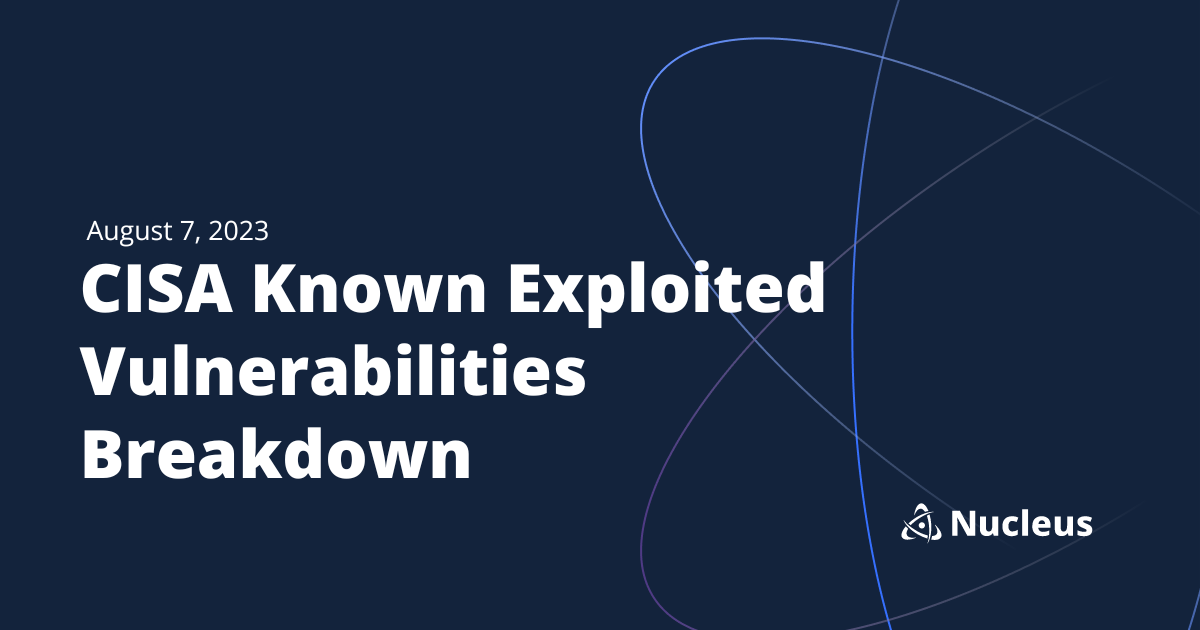August 7, 2023 CISA KEV Breakdown | Zyxel

August 7: 1 New Vuln | CVE-2017-18368
In this CISA KEV Breakdown, one vulnerability in Zyxel P660HN-T1A and Billion 5200W-T routers from 2017 was added. With a monstrous EPSS score for months and a metasploit module to boot, it is no surprise this vulnerability is continuously looked for by attackers as an opportunistic exploit.
[wptb id=22392]Notable Vulnerability Additions
CVE-2017-18368 | Zyxel Router Command Injection
A vulnerability exists affecting two versions of Zyxel firmware and one version of Billion firmware that contains a command injection vector within the ViewLog.asp page, which is accessible to an unauthenticated user. An attacker must supply a malicious prompt through the remote-host parameter within the page to successfully exploit the vulnerability.
Affected versions:
- Zyxel p660HN-T1A V2 Firmware
- Zyxel p660HN-T1A V1 Firmware
- Billion 5200W-T Firmware
It is not clear what exploitation activity CISA determined as being observed which dignified it’s addition to the KEV, as a fix has been available for this vulnerability for quite some time and known exploitation appears highly likely according to various reports. CISA linked directly to the Zyxel advisory from 2019 relating to Palo Alto’s Unit 42 and their reporting on home and small-office routers being exploited using a gafgyt variant discovered in 2019.
Below is a screenshot from their report, which you can observe an attacker injecting a chmod command into the remote-host parameter.
The agregious record of scanning activity according to GreyNoise as well as sitting in the 100th percentile in EPSS scores certainly drives home the likelihood that this vulnerability has been pursued by attackers for quite some time. Organizations should take the addition to the KEV as a reminder to review attack vectors found often in small but not any less important places such as this one.
Security Advisory(s):
← July 31, 2023 CISA Kev Breakdown
Click here to expand our CISA KEV Breakdown Frequently Asked Questions
- What makes for a notable addition?
- A notable addition can arise from many different characteristics. If a particular vulnerability is notable to the security community or a subset of the security community or if the EPSS score reveals notable information about the vulnerability, this can constitute further analysis. It may also be the case that a particular vulnerability shines a light on everyday users and we will highlight important information and key takeaways to ensure users and readers have easy access to actionable information.
- When is the Breakdown released?
- We aim to have our analysis of each KEV update posted within 24 hours of the time in which the Catalog is updated. See CISA’s full catalog here
- I am not bound by BOD 22-01 or federal regulations, why should the KEV concern me?
- CISA encourages all organizations to utilize the Catalog as an attribute in your vulnerability prioritization framework. Organizations looking to lessen the scope on known dangerous vulnerabilities and make a goal to remediate them can understand where they currently stand against what CISA has confirmed as exploited vulnerabilities in the wild. See CISA’s section on “How should organizations use the KEV catalog?” here.
- What is EPSS?
- EPSS is the Exploit Prediction Scoring System. It is an open, data-driven effort for estimating the likelihood (probability) that a software vulnerability will be exploited in the wild. See the EPSS home page on FIRST for more information here.
- What is the difference between EPSS probability and EPSS percent?
- EPSS probability is the risk calculated by the model when determining the perceived threat of the vulnerability itself. Percentage is a relative comparison of the rest of the CVEs within the given sample. While the probability only changes upon refreshing the results from the model, the percentage can change purely based on the CVE sample given. In the case of the Breakdown, we use the percentage given by the pool of all CVEs with given EPSS data. Scores may vary post-release of the post given new information about the vulnerabilities and their perceived threat. For more information on applying and understanding EPSS data, see this article on the FIRST website, as well as their FAQ page.
- What is GreyNoise?
- GreyNoise is a platform that collects, analyzes, and labels data on IPs that scan the internet and saturate security tools with noise. Through their sensor network, GreyNoise observes vulnerability exploitation attempts for vulnerabilities that are exploited in the wild over the Internet. These are arguably vulnerabilities that should be at the very top of your priority list to remediate.
- Why are GreyNoise exploitation attempts only observed on ~20% of KEV vulnerabilities?
- Exploitation of many vulnerabilities in the CISA KEV will not be observed for many reasons that GreyNoise does a good job of explaining in this post. For example:
- The vulnerability may not be remotely exploitable
- Vulnerability exploitation may require authentication (and result in privilege escalation)
- The impacted software may not be exposed to the internet
- Mass scanning/exploitation is not occurring yet
- Exploitation of many vulnerabilities in the CISA KEV will not be observed for many reasons that GreyNoise does a good job of explaining in this post. For example:
See Nucleus in Action
Discover how unified, risk-based automation can transform your vulnerability management.































